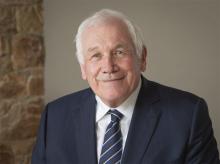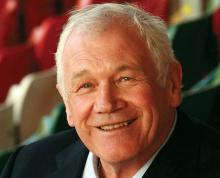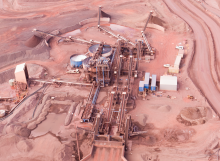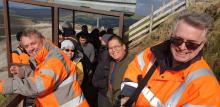
Valérie Philip is Cemex France's first female quarry manager. Paul Howard finds out how she became such a trailblazer.
There are some professions that are historically associated with women - nursing, for example, or primary school teaching. Equally, there are some areas of the working world that have remained obstinately male oriented and the physically demanding industry of quarrying is one of the most intransigent.
This is not necessarily a fault of the quarrying sector itself and the reasons for the situation are many and complex, but there are a few women who are bucking this trend. One of those is Valérie Philip, who has become the first female quarry manager for
In the country that created the word chauvinism and in which experience is still deemed to count for a lot (last year's election of President Sarkozy, aged a mere 52, was little short of remarkable; his predecessors, Presidents Chirac and Mitterand, retired at the age of 74 and 79, respectively), this combination of youth and femininity could be seen as significant handicap.
Little surprise, then, to find that one of the biggest challenges Philip said she has faced in her nine months in the job has been to be taken seriously by her neighbours; after all, she and the quarry are merely tenants. In particular, ensuring she is on good terms with the mayor of the local commune, France's smallest administrative unit but one that still carries considerable weight, has been vital. This, after all, is an essential cog in the de-centralised French state system.
"The most important thing has been managing the relationships with neighbours," she explained. "You've got to be up front and tell them what you're doing, and you've got to keep up to speed with the regulations that govern what you're doing." Philip has also had to acquire an awareness of the work undertaken by her neighbours. She is situated in the predominantly agricultural Eure et Loire department, near Chartres, which is 100km to the south-west of Paris and largely an arable farming area.
"We quarry limestone in an agricultural area, so I've got to know when they'll be harvesting their crops, for example, and when they might want to use a lot of water for irrigation. You've really got to explain things to them, and keep them right up to date," she said. The effort is rewarded, she claimed, by avoiding confrontations with people with whom it is essential to maintain a working relationship and by keeping on the right side of France's renowned bureaucracy.
It is only after all this, on the list of challenges she has faced so far, that the outwardly daunting prospect of running a quarry itself is mentioned.
"Yes, I am the person responsible for the site and for its production," she acknowledged. "That means I look after everything from extraction itself through to sales, including the quality of the product, environmental and health and safety issues as well as, as I mentioned, our relationship with neighbours and the local authorities." Major sales to larger clients are, in fact, negotiated and dealt with at a regional level within the company, she pointed out, but added, "It's still my job at the quarry to inform the company of what we have available." Although Philip is clearly not one to make a mountain out of a molehill, the general housekeeping issues associated with running a quarry are not easily dismissed. Demands placed on her role include ensuring electricity is used most efficiently - "We modify our output depending on when demand is highest and lowest elsewhere, and when tariffs change accordingly" - and recycling as much water as possible. "We analyse the water tables in the vicinity to check levels and ensure that we're not inadvertently polluting them." More obviously difficult is managing one of the aspects that might traditionally have been assumed to attract men to the industry - the safe use of explosives on the site. Philip has the qualifications required to carry out the explosions herself, and regularly puts this training to good use. "I'm the one who pushes the plunger," she said with a degree of relish.
Another, unanticipated challenge in her tenure to date has been the deterioration in the wider economic climate. This, she said, has meant coping with a significant fall in production levels. "We've been waiting for things to pick up since the traditional holiday-induced lull in July and August, and they've not really done so. Sales have been down by up to 50%." You might be forgiven for thinking that, to put yourself through such a steep learning curve, and overcome odds that have defied other women for a considerable length of time, you must have an innate passion for the job in hand. You would, however, be mistaken.
The furthest Philip can trace her interest in quarrying only dates back a decade or so, to her time as a student spent studying environmental and biological sciences. "As part of this, I received training in the requirements for compliance with the
As a result of this placement, she then obtained a post as a health and safety advisor for all Cemex's quarries in the region. "That was in 2003," she recalled. "My responsibility was to ensure the sites complied with all the relevant legislation, that's to say regulations governing everything from site security to individual worker safety. I also had to ensure the workers were aware of their responsibilities under the regulations and, by and large, they were receptive to this." Her diligence was obviously considerable. The region has since gone three and a half years without an accident; at her current quarry, the tally is six years and counting.
"I did this until 2005, when I became head of the project to audit the environmental performance of the company's cement plants - not just CO2 emissions, but also the dust produced on the sites, the volumes of water used and discharged and what happens to it once discharged," she said.
A year later, Philip moved on once more to begin a training course to become a quarry manager. The course, which lasted two years and involved three weeks learning on site and one week's study, was facilitated by the French aggregates association
At which point, Philip had to assume the hot seat but was this transition from protégé to leader a major leap? "It wasn't too, too difficult," she said. "I already knew most of the people I'd be working with. I'd spent two years working with them while I was studying, so they'd mostly become used to me." That's not to say everything went entirely smoothly, however. "They test you, nevertheless," she admited. "Suppliers can be the most difficult, though even then it's not too serious, and anyway, I'm not bothered by it. You've just got to show them you know what you're doing." Conventional wisdom has it that the best way to do this is in any new environment is to get involved, a philosophy that Philip was more than happy to put into practice. "I'm not afraid to get my hands dirty, to get involved in fixing a machine, for example. I show I'm interested in everything that goes on in the quarry. I accept that I've got to prove myself. It's been nine months so far and everything's gone well," she explained.
After such a rapid progression up the industry career ladder, and even though she's been in her current post for less than a year, it seems pertinent to ask what might come next. "That would probably be to move up to quarry management at a regional level, within Cemex," she said. "They're good at encouraging internal progression, and there is lots of supplementary and on-the-job training if necessary. If you fancy trying to do something, it's just a question of speaking to the management team." First, though, she has to continue her initiation into quarry management. In particular, she has to deal with the small matter of moving to a new site. "We've actually finished extracting material from the current 41ha site, and are moving to a new location down the road," she said.
As well as the transfer itself, Philip is also responsible for reinstating the current site. "The first phase of this is to create embankments from inert material to stop contamination of the water table. Then we'll refill it to a predetermined height - 9m - before covering with top soil and returning the land to use as agricultural fields, at which point it will be handed back to the proprietor. If all goes well, this will be done by 2018," she explained.
Until then, the processing plant on the current site will continue to be used for material extracted from the new quarry, which is situated just 3km away. "We've got to do this as we can't install a new processing plant until we've excavated the new site to a certain depth, which we'll probably have achieved in four years time," said Philip.
The inconvenience associated with this wait and the logistical difficulties of shipping the raw material between the sites in a fleet of six lorries are easily offset by the potential of the new site: it covers 150ha and will eventually produce up to 800,000tonnes per year. Philip's own potential seems equally promising.










